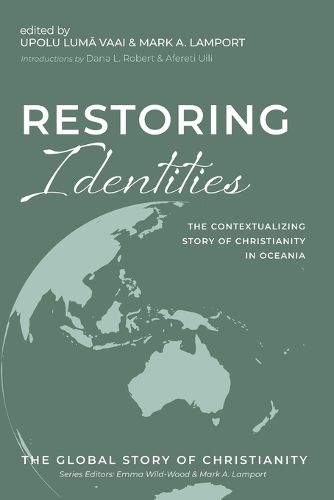Readings Newsletter
Become a Readings Member to make your shopping experience even easier.
Sign in or sign up for free!
You’re not far away from qualifying for FREE standard shipping within Australia
You’ve qualified for FREE standard shipping within Australia
The cart is loading…






This title is printed to order. This book may have been self-published. If so, we cannot guarantee the quality of the content. In the main most books will have gone through the editing process however some may not. We therefore suggest that you be aware of this before ordering this book. If in doubt check either the author or publisher’s details as we are unable to accept any returns unless they are faulty. Please contact us if you have any questions.
In a sense, Oceania can be considered a microcosm of World Christianity. Within this region are many of the same observable trends on the global level that impact Christian life, faith, and witness. The geography of Oceania--the "liquid continent"--is unique. Christianity arrived in Australia and New Zealand in the late eighteenth century via British colonial powers. Indigenous Aboriginal peoples, Torres Strait Islanders, and Maori peoples were dispossessed of land, property, rights, and dignity. Christianity grew by migration and conversion (not always voluntary), and over time became tightly intertwined with culture. In the twentieth century, rapid secularization moved Christianity into the private sphere, and by 2020 Christian affiliation had dropped from 97 percent to 57 percent. However, the history of Christianity in the Pacific Islands--Melanesia, Micronesia, and Polynesia--is quite different. Christianity arrived via Protestant and Catholic missionaries between the fifteenth and nineteenth centuries and grew substantially in the twentieth century largely due to indigenous Christian efforts. Islanders brought Christianity to neighboring islands, indigenous theologies developed, and churches gradually separated from their Western mission founders. One of the great "success stories" of World Christianity is Papua New Guinea, which grew from just 4 percent Christian in 1900 to 95 percent in 2020. However, growth is never the entire story. Violence against women is endemic in Papua New Guinea and is often combined with accusations of witchcraft. An estimated 59 percent of women have experienced physical or sexual violence in their lifetime (and 48 percent in the last year). As Christianity continues its shift to the global South, it becomes increasingly critical to heed the experiences, perspectives, and theologies of Christians, particularly women, in the Pacific Islands.
$9.00 standard shipping within Australia
FREE standard shipping within Australia for orders over $100.00
Express & International shipping calculated at checkout
This title is printed to order. This book may have been self-published. If so, we cannot guarantee the quality of the content. In the main most books will have gone through the editing process however some may not. We therefore suggest that you be aware of this before ordering this book. If in doubt check either the author or publisher’s details as we are unable to accept any returns unless they are faulty. Please contact us if you have any questions.
In a sense, Oceania can be considered a microcosm of World Christianity. Within this region are many of the same observable trends on the global level that impact Christian life, faith, and witness. The geography of Oceania--the "liquid continent"--is unique. Christianity arrived in Australia and New Zealand in the late eighteenth century via British colonial powers. Indigenous Aboriginal peoples, Torres Strait Islanders, and Maori peoples were dispossessed of land, property, rights, and dignity. Christianity grew by migration and conversion (not always voluntary), and over time became tightly intertwined with culture. In the twentieth century, rapid secularization moved Christianity into the private sphere, and by 2020 Christian affiliation had dropped from 97 percent to 57 percent. However, the history of Christianity in the Pacific Islands--Melanesia, Micronesia, and Polynesia--is quite different. Christianity arrived via Protestant and Catholic missionaries between the fifteenth and nineteenth centuries and grew substantially in the twentieth century largely due to indigenous Christian efforts. Islanders brought Christianity to neighboring islands, indigenous theologies developed, and churches gradually separated from their Western mission founders. One of the great "success stories" of World Christianity is Papua New Guinea, which grew from just 4 percent Christian in 1900 to 95 percent in 2020. However, growth is never the entire story. Violence against women is endemic in Papua New Guinea and is often combined with accusations of witchcraft. An estimated 59 percent of women have experienced physical or sexual violence in their lifetime (and 48 percent in the last year). As Christianity continues its shift to the global South, it becomes increasingly critical to heed the experiences, perspectives, and theologies of Christians, particularly women, in the Pacific Islands.